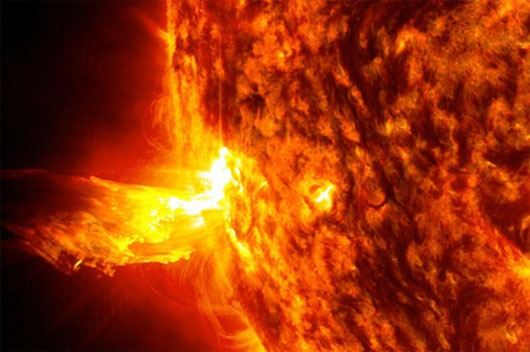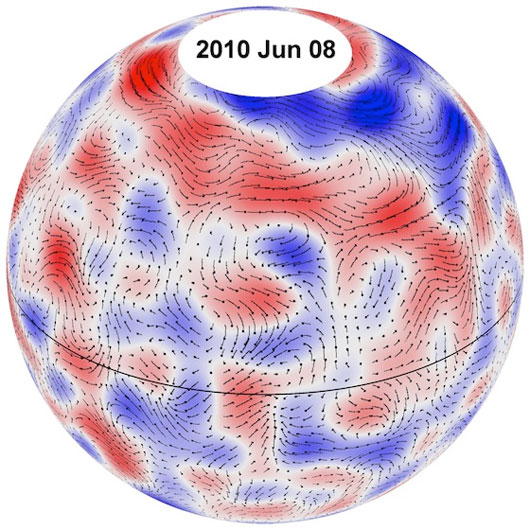NASA revealed the mysteries in the sun
Scientists have predicted that the sun has a particle-like structure (matter particle). Each particle of this matter can be 16 times larger than the Earth.
The sun, like many other stars, has a layer of thermal conductivity from the core to the surface. This heat conduction process creates "solar streams" , which are huge particles of charged particles from the sun. For decades, scientists have discovered particles that are transmitted in these "sun streams".

Finding huge particles will help people better understand the sun
More specifically, scientists believe that there are many small particles of matter (about the size of the US state of Texas) that exist only for 10 minutes and there are many larger particles called " Super particles " exist within 1 day, about the size of 3 times the width of the Earth. The discovery of small particles and "sparticles" helps scientists theorize that these particles are in a multi-level system that makes up the solar flux, and therefore particles can exist " giant " , bigger than the super beads very much.
Finding these giant particles is quite a difficult task. The most important reason is because they move very slowly, and therefore humans are hard to detect. Small particles have a speed of about 3,000 meters per second; Super particles have a speed of 500 meters per second, while giant particles are only about 10 meters per second (equivalent to Usan Bolt's speed). Therefore, their movements are too faint to be recognizable.
David Hathaway's (NASA) report recently officially confirmed the existence of giant particles by tracking super particles. Dr. Hathaway and his colleagues used the Solar Dynamics Telescope (SDO) to track the sun once every 45 seconds for months. By careful measurement, they discovered that the sparticles were moved by the giant particles that humans searched for long.

The path of giant particles in 2010
These massive particles also make the sun spin around its axis faster. " The analogy of the sun with the earth's weather system is huge," Dr Hathaway said. "These particles are moving the magnetic field on the surface and the solar core follows the same way that the Earth's weather system moves steam . " Both small particles and super particles move from the field, and according to Dr. Hathaway, so are giant particles. This phenomenon can affect the strength of the magnetic field at the two poles of the sun - how strong this magnetic field will be to determine the increase and decrease of black traces within 11 years.
Dr. Hathaway hopes that this finding will help to better understand the location of the sun's black spots."We are investigating where black spots are formed and whether they are based on the sun's flow." Although there have been many theories about the location of black spots based on these giant particles, it is not easy to find the correct connection.

If you understand the dark spots, people can monitor the phenomena that may affect the Earth's weather
The next step of Dr. Hathaway and experts at NASA is to monitor how the magnetic field will react to the solar currents inside giant particles."Everything on the sun is related to the magnetic field: Flower-rimmed ribbons, flares, coronary coronary material (CME)," said Dr. Hathaway.
Finding a link between solar and magnetic fields will help scientists predict better solar storms, and find out if they will affect the solar system (Mars, Earth, Defense). human essence .) how. "What does a solar storm look like? If there's a blemish and CME, how will they move in space? It's all decided by what the magnetic field will do on the surface of the sun. I think we has come a step closer, because we can now see the sun's rays ".
- NASA reveals driver 'monster car on Mars'
- NASA built WFIRST wide-angle telescopes, hunting life out of Earth
- NASA lost the computer containing the ISS control code
- NASA revealed the explorer machine withstand 450 ° C
- NASA also needs 'witch' photoshop
- After tens of years, NASA finally revealed its 'secret' inventions
- NASA accidentally 'revealed' the video of 3 mysterious objects leaving Earth
- NASA: ISS is falling
- NASA launches a spacecraft to explore the sun's mystery in 2018
- NASA director revealed the first person to Mars
- NASA has just opened two new missions to learn more about the Sun.
- 5 greatest scientific achievements in NASA history
 Van Allen's belt and evidence that the Apollo 11 mission to the Moon was myth
Van Allen's belt and evidence that the Apollo 11 mission to the Moon was myth The levels of civilization in the universe (Kardashev scale)
The levels of civilization in the universe (Kardashev scale) Today Mars, the sun and the Earth are aligned
Today Mars, the sun and the Earth are aligned The Amazon owner announced a secret plan to build a space base for thousands of people
The Amazon owner announced a secret plan to build a space base for thousands of people